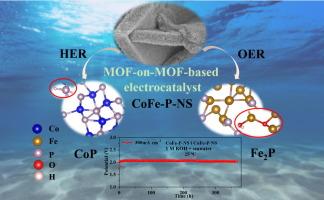p-d轨道杂化增强MOF-on-MOF衍生CoP/Fe2P双金属磷化物电催化剂用于稳定水电解
IF 14.9
1区 化学
Q1 Energy
引用次数: 0
摘要
设计和制造有序外延MOF-on-MOF异质结构作为高效的水分解电催化剂是至关重要的,但仍然具有挑战性。在本研究中,采用简单的配位驱动自组装方法制备可控MOF-on-MOF多尺度异质结构,其中三角形主体MOF (ZIF-67)纳米片通过原位外延生长形成均匀的正交客体MOF (CoFe - PBA)纳米片。进一步在原位引入磷(P)制备了CoP和Fe2P异质结构纳米片(CoFe-P-NS),通过P- d轨道杂化增强了本构电催化活性,表现出优异的双功能电催化性能。具体来说,fe - p - ns的HER和OER分别需要259和307 mV的低过电位才能达到500 mA cm - 2。值得注意的是,组装后的电解槽在碱性海水电解过程中保持了300 mA cm−2的大电流密度,持续时间超过360 h,电压升高可以忽略不计。实验和理论计算表明,双金属磷化物的协同催化活性来自p-d轨道杂化,其中CoP-P位点通过优化Volmer-Heyrovsky步骤中的H*吸附来增强HER,而Fe2P-Fe位点通过降低从O*到OOH*的速率决定步骤的能垒来加速OER。该研究为设计基于mof -on- mof的可控碱性海水分解电催化剂提供了有价值的见解。本文章由计算机程序翻译,如有差异,请以英文原文为准。

p-d orbital hybridization enhanced MOF-on-MOF derived CoP/Fe2P bimetallic phosphide electrocatalyst for stable water electrolysis
The design and fabrication of ordered epitaxial MOF-on-MOF heterostructures as highly efficient electrocatalysts for water splitting is crucial but still challenging. In this study, a simple coordination-driven self-assembly method is used to fabricate controllable MOF-on-MOF multiscale heterostructures, where triangular host MOF (ZIF-67) nanosheets undergo in situ epitaxial growth to form uniform orthogonal guest MOF (CoFe PBA) nanosheets. Phosphorus (P) is further introduced in situ to fabricate CoP and Fe2P heterostructured nanosheets (CoFe-P-NS), which exhibit excellent bifunctional electrocatalytic performance due to the enhancement of intrinsic electrocatalytic activity by p-d orbital hybridization. Specifically, the CoFe-P-NS requires low overpotential of 259 and 307 mV to reach 500 mA cm−2 for HER and OER, respectively. Remarkably, the assembled electrolysis cell maintained a large current density of 300 mA cm−2 for over 360 h with negligible voltage increase during alkaline seawater electrolysis. Experiments and theoretical calculations show that the synergistic catalytic activity of bimetallic phosphides arises from p-d orbital hybridization, where the CoP-P sites enhance HER by optimizing H* adsorption in the Volmer-Heyrovsky steps, while the Fe2P-Fe sites accelerate OER by lowering the energy barrier of the rate-determining step from O* to OOH*. This study provides valuable insights into the design of a controllable MOF-on-MOF-based electrocatalyst toward alkaline seawater splitting.
求助全文
通过发布文献求助,成功后即可免费获取论文全文。
去求助
来源期刊

Journal of Energy Chemistry
CHEMISTRY, APPLIED-CHEMISTRY, PHYSICAL
CiteScore
19.10
自引率
8.40%
发文量
3631
审稿时长
15 days
期刊介绍:
The Journal of Energy Chemistry, the official publication of Science Press and the Dalian Institute of Chemical Physics, Chinese Academy of Sciences, serves as a platform for reporting creative research and innovative applications in energy chemistry. It mainly reports on creative researches and innovative applications of chemical conversions of fossil energy, carbon dioxide, electrochemical energy and hydrogen energy, as well as the conversions of biomass and solar energy related with chemical issues to promote academic exchanges in the field of energy chemistry and to accelerate the exploration, research and development of energy science and technologies.
This journal focuses on original research papers covering various topics within energy chemistry worldwide, including:
Optimized utilization of fossil energy
Hydrogen energy
Conversion and storage of electrochemical energy
Capture, storage, and chemical conversion of carbon dioxide
Materials and nanotechnologies for energy conversion and storage
Chemistry in biomass conversion
Chemistry in the utilization of solar energy
 求助内容:
求助内容: 应助结果提醒方式:
应助结果提醒方式:


